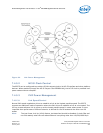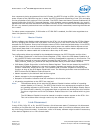
Power-State Transitions Timing — Intel
®
82575EB Gigabit Ethernet Controller
324632-003 Intel
®
82575EB Gigabit Ethernet Controller
Revision: 2.1 Software Developer’s Manual and EEPROM Guide
January 2011 227
7.4.2.2 Transition from D0a to D3 and Back without PE_RST_N
13 A first PCIe* configuration access might arrive after t
pgcfg
from PE_RST_N de-assertion.
14 A first PCIe* configuration response can be sent after t
pgres
from PE_RST_N de-assertion.
15 Writing a 1b to the Memory Access Enable bit in the PCI Command Register transitions the 82575 from D0u to D0
state.
Notes
1 Writing 11b to the Power State field of the Power Management Control/Status Register (PMCSR) transitions the 82575
to D3.
2 The system keeps the 82575 in D3 for an arbitrary amount of time.
3 To exit D3, the system writes 00b to the Power State field of the Power Management Control/Status Register
(PMCSR).
4 APM wake up or SMB mode can be enabled based on the EEPROM contents.
5 After reading the EEPROM, the reset to the PHY is de-asserted. The PHY operates at a reduced speed if APM wake up
or SMB is enabled. Otherwise, it is powered down.
6 The system can delay an arbitrary time before enabling memory access.
7 Writing a 1b to the Memory Access Enable bit or to the I/O Access Enable bit in the PCI Command Register transitions
the 82575 from D0u to D0 and returns the PHY to full power and full speed operation.
Notes
PCIe*
Reference Clock
PCIe* PwrGd
PHY Reset
PCIe* Link
Reading EEPROM Read EEPROM
DState D3 D0u D0
Wakeup Enabled
Memory Access Enable
L0
D3 write
APM / SMBusAny mode
D0 Write
D0a
2
L1
L0
PHY Power State
full FullPower Managed Power Managed
tee
1
3
4
5
6
7
td0mem


















